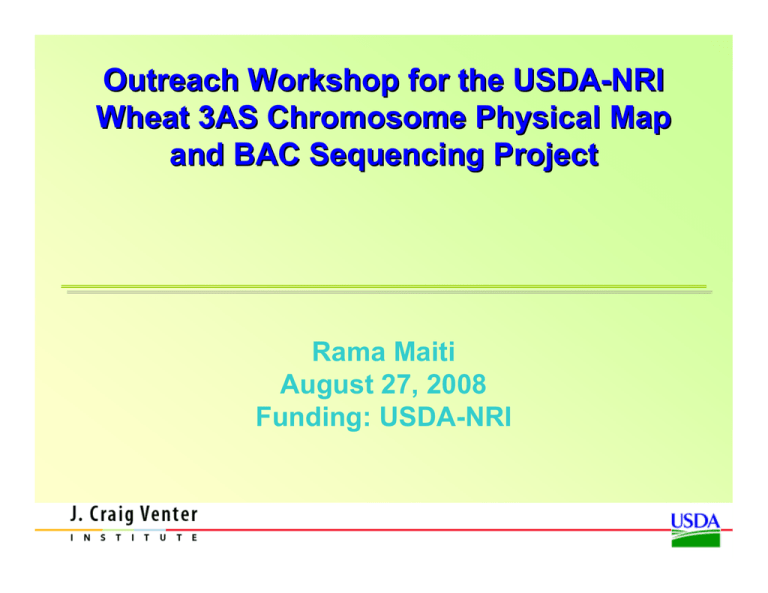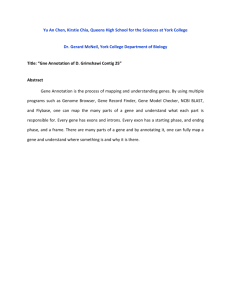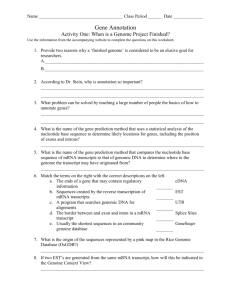Outreach Workshop for the USDA - NRI Wheat 3AS Chromosome Physical Map
advertisement

Outreach Workshop for the USDA-NRI Wheat 3AS Chromosome Physical Map and BAC Sequencing Project Rama Maiti August 27, 2008 Funding: USDA-NRI Sequence Annotation: Why? • Raw sequence data is not meaningful to biologists. • To be meaningful/useful it has to be converted into biological significant knowledge : markers, genes, RNAs, protein sequences. • Genome annotation is the first step toward this knowledge acquisition. 2 Annotation Process The annotation mainly consists of these steps: – Structural annotation: defining the structure of each transcript and structural element. – Functional annotation: classifying each element, attributing, when possible, a specific function. – Display of the Annotation Data: The data are uploaded to a genome browser for viewing and accessing the data. 3 Gene Finding: Flowchart EST/ cDNAs Repeat Masking tRNA Prediction Ab-initio Gene Prediction Genome Browser Preliminary Gene Structures Gene Structure Refinements Final Gene Models Sequence Homology Searching Proteins Genome Browser EST Transcript Assemblies PASA Genome Browser 4 Repeat Masking • Fragments of transposons are often confused for proteincoding exons of genes. • Identification of repeats in the genome and masking the repeats from the sequence becomes necessary for good quality annotation. • Prior to gene finding efforts, repetitive elements were identified and masked by Repeatmasker using JCVI plant repeat database. 5 Homology Evidence • AAT gapped alignments (Huang, 1997) – In house Non redundant protein database – Rice protein database – In house Plant Transcript Assemblies (TA) • EST: PASA Spliced Transcript Assemblies (PASA -http://sourceforge.net/projects/pasa) – Wheat ESTs/cDNAs are aligned to the genome and assembled. 6 Ab-initio Gene Predictions • Different gene prediction software uses different computational algorithms. It is important to use the most suitable ones. • Following gene finders have been optimized and used for wheat BAC annotation in JCVI. – – – – FGENESH (monocot) Genscan (Maize) Genscan+ (Arabidopsis) GlimmerHMM (rice) • FGENESH predictions are modeled as gene models. • Other predictions are viewed as the evidence in the genome browser. 7 Gene Model Refinement with Experimental Evidence Preliminary Gene Structure Refined Gene Structure EST assemblies are best evidence for improving the gene structure with correct intron/exon boundaries. 8 Functional Annotation Flowchart Gene Product Sequence Pfam Domains HMM Searches Proteins BlastP Searches Assignments Gene Product Name Manual curation 9 Functional Annotation: Naming the Gene Product Gene products are named based on the following nomenclature. • Known, Putative: Identical or strong similarity to documented gene(s) in Genbank or has high similarity to a Pfam domain • Domain Protein: Has high similarity to a Pfam domain • Expressed protein: Only match is to an EST with an unknown function • Hypothetical: Predicted solely by gene prediction programs 10 Display of Annotation Resources • Wheat genomic or annotated data is accessible through JCVI wheat web site. (http://wheat.tigr.org) • The BAC sequence and the annotation features are displayed in the context of its supporting evidence through a genome browser. 11 Improvement in Annotation Pipeline: Combining the Evidences Start End Repeat Masking EVidenceModeler (EVM) Combines predicted exons and alignments into weighted consensus gene structures weight PASA transcript alignment assemblies Genewise protein alignments Gene Predictions, AAT alignments Ab-initio Gene Prediction Sequence Homology Searching Combining Evidence Consensus Gene Structure 12 Acknowledgment Project Director: • Bikram S. Gill, Kansas State University, USA Collaborators: • Rudi Appels, Murdoch University, Australia • Jaroslav Dolezel, Institute of Botany, Czech Republic Co-Project Directors: • Katrien M. Devos, University of Georgia • Jan Dvorak, University of California, USA • Justin D. Faris, USDA–ARS • Catherine Feuillet, INRA-UBP, • Piotr Gornicki, University of Chicago Clermont-Ferrand, France • Wanlong Li, Kansas State University • Ming-Cheng Luo, University of California • C. Robin Buell, Michigan State University Davis, USA • • Pablo Rabinowicz, Institute for Genome Sciences, U. of Maryland USA Agnes Chan, J. Craig Venter Institute, USA • JCVI Annotation Group 13







